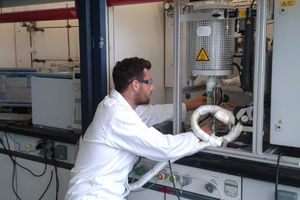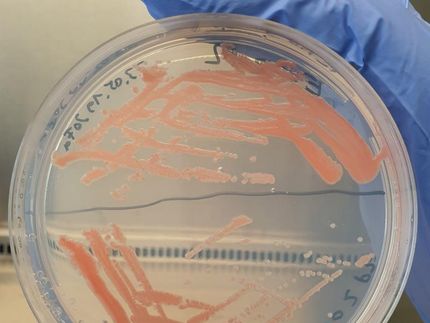Green Fuel from Carbon Dioxide
Freiburg Research Team Develops Method for Sustainable Use of CO2
Advertisement
It is beyond dispute that carbon dioxide (CO2) has an effect on global warming as a greenhouse gas, but we still pump tons and tons of CO2 into the atmosphere every day. A research team at the Freiburg Materials Research Center (FMF) led by the chemist Prof. Dr. Ingo Krossing has now developed a new system for producing Methanol that uses CO2 and hydrogen. Methanol can, for example, be used as an environmentally friendly alternative for gasoline. The goal of the scientists is to harness the power of CO2 on a large scale and integrate it into the utilization cycle as a sustainable form of energy production.

Doctoral candidate Elias Frei controls the temperature in the reactor of the catalyst test device.
FMF
In order to produce methanol, Krossing’s doctoral candidates combine the carbon dioxide with hydrogen in a high pressure environment, a process known as hydrogenolysis. Doctoral candidate Elias Frei has already been conducting research on methanol for several years. “Our goal is to develop new catalyst systems and methods for accelerating the chemical reaction even more,” explains Frei. The researchers at FMF use the metal oxides copper, zinc, and zirconium dioxide as catalysts, enabling the reaction to happen at lower temperatures. In this way, the gases don’t have to be heated as much. Together the catalysts form a so-called mixed system of surface-rich porous solid matter with defined properties. If the catalysts consist of nanoparticles, their activity is increased even more.
Frei and his colleague Dr. Marina Artamonova are also testing techniques in which the catalysts are impregnated with ionic liquids, salts in a liquid state that cover the catalyst like a thin film. They help to fix CO2 and hydrogen to the catalyst and remove the products methanol and water from it. This conversion leads to the production of pure methanol, which is used as a component in the chemical industry and as a fuel. When used as an alternative to gasoline it is less dangerous and less harmful to the environment than conventional fuels. In around two years, the researchers aim to be able to produce methanol on a mass scale according to this technique. Then the CO2 will be filtered out of the waste gas stream of a combined heat and power plant and used to produce methanol. When methanol is burned in a motor, CO2 is released again. If the same molecule were used twice, it would theoretically be possible to use 50 percent less CO2 to create the same amount of energy. The amount of methanol that could be converted from 10 percent of the yearly CO2 emissions in Germany would cover the country’s yearly fuel needs.
Methanol is also used as a chemical means of hydrogen storage and could thus also be used to power the fuel cells of automobiles in the future. “There is enough energy out there, but it needs to be stored,” says Frei. “As a sustainable means of energy storage, methanol has potential in a wide range of areas. We want to use that potential, because the storage and conversion of energy are important topics for the future.”




























































